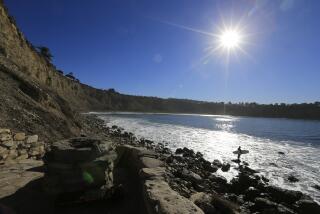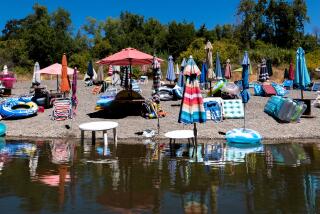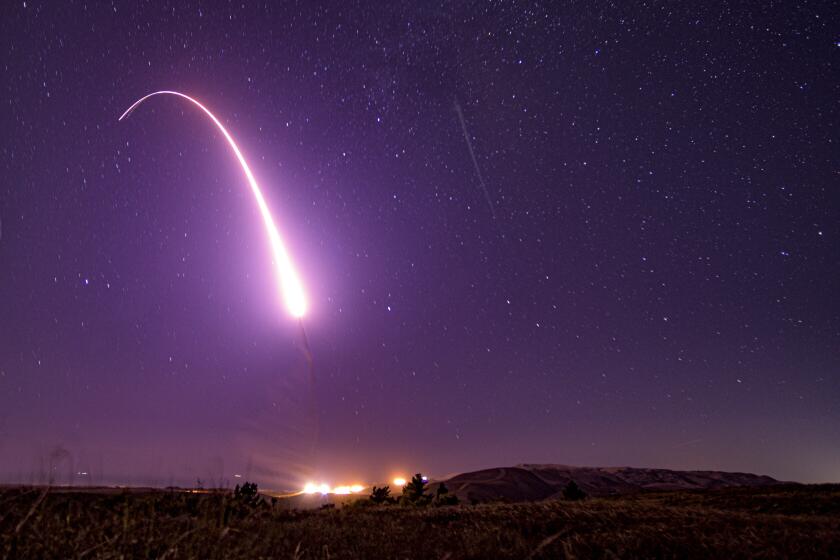Beach Battles : Lifeguards: The watchers on the shore say their job no longer is idyllic as violence and big-city problems intrude. ‘You’re a quasi-policeman,’ one laments.
- Share via
They are an enduring symbol of Southern California: the tanned, red-suited lifeguards who make a career of spending all day at the beach.
In their Los Angeles County caps--and, of course, shades--they train their eyes over the water from their towers, watching for distressed swimmers and showing off their muscles.
For the record:
12:00 a.m. May 11, 1991 For the Record
Los Angeles Times Saturday May 11, 1991 Home Edition Metro Part B Page 3 Column 5 Metro Desk 1 inches; 31 words Type of Material: Correction
Lifeguards--A photo caption in Thursday’s Times incorrectly said lifeguard Tony Bardin was pelted by cans and bottles during a rescue at Santa Monica Pier. In fact, the incident happened to another lifeguard, Jon Moryl.
That is the image. But those who guard more than 30 miles of Los Angeles County coast confront a different reality today, as problems of the inner city crowd the shoreline.
Increasingly, lifeguards are on the front line, dealing with growing numbers of homeless panhandlers, unruly crowds of drunks and even gangs fighting on the sand.
“I think violence in general has risen throughout the society and we’re seeing it on the beach as well,” said Randy DeGregori, assistant chief of the Los Angeles County lifeguard corps.
“Ask any lifeguard who’s been doing this a while if they ever expected the job to turn into what it has, and the answer is no,” said Jon Moryl, 36, a former schoolteacher who has been a lifeguard, full- or part-time, for 18 years. “You’re a quasi-policeman, lifeguard and social director all rolled into one.”
A sampling of what the county’s 117 full-time and 631 part-time lifeguards have encountered:
* A gang confrontation among 70 youths at Zuma Beach early last month sent beach-goers scattering. One 17-year-old was stabbed with a screwdriver.
* A lifeguard was pelted with cans and bottles by a crowd on the Santa Monica Pier a week ago as he tried to rescue a man who had jumped into the water.
* At the same beach two years ago, another lifeguard was stabbed by a transient with a corkscrew after refusing to give a handout. The guard was not seriously hurt but was out of work for three weeks after falling off his tower in the attack, landing on his back eight feet below.
Lifeguards are unarmed and carry only rescue cans for pulling drowning victims to shore. “Basically we’re out here in our underwear,” said John Renaud, a lifeguard for 20 years, assigned to Malibu’s Zuma Beach.
Self-defense instruction was added to lifeguard training two years ago, said Robert Buchanan, the division’s training supervisor. There are no records of how many guards have been injured in attacks, he said, but a study found that 50 assaults or serious threats had occurred against lifeguards over a recent two-year period.
Despite their increasingly high-tech array of communications systems, computers and radar-equipped boats for rescues, lifeguards often have to deal with more subtle human issues. They preside over beaches used year-round--62 million people in 1990.
As the ethnic mix of Los Angeles changes, an increasing number of beach-goers are recent arrivals who may not be familiar with the water or interested in swimming.
“It’s not an ocean-oriented public any more,” said Terry Hearst, a lifeguard for 17 years.
As a result, Buchanan said, communication skills are being more and more emphasized during training. “We talk about the need for sensitivity with beach visitors,” Buchanan said, “to make sure people realize they must deal with different languages and customs.”
“We would like to hire more people with an ethnic diversity,” Buchanan added. According to records, 617 of the 748 lifeguards are white males and 61 are white females. Black, Latino and Asian guards make up less than 10% of the corps.
Lifeguards say they see their mission as helping people, much like firefighters, but say they find themselves called “water pig” or other epithets when they try to enforce laws against drinking or barbecues on the beach.
Moryl said he has dealt with belligerent crowds, intervened in domestic squabbles and given emergency medical aid in the aftermath of gang fights. He thought he had seen it all until he went to rescue the man who jumped off Santa Monica Pier. “Cans and bottles started raining down,” apparently to dissuade him from the rescue, he said. “I was aghast. Nothing like that has ever happened.”
Moryl called for police assistance. “When I came on, it was unheard of to get involved in police matters,” he said. “Now we couldn’t do this job without them.”
Over the last several years, local police agencies such as the Los Angeles Police Department and Los Angeles County Sheriff’s Department have set up beach patrol details to enforce laws and respond more quickly to incidents.
“The beach details have made our job a lot easier,” said Don Rohrer, chief of the lifeguard division, “so police can do the policing and lifeguards lifeguarding. That’s the way we like it.”
Sheriff’s deputies broke up the April melee at Zuma Beach, although it was lifeguards who alerted them as the gang members arrived, sticks and bats in hand, 15 minutes before the trouble broke out.
The lifeguards did not get involved, said Russ Walker, lifeguard supervisor at Zuma. “I had a guard in the area and I told him if a fight breaks out, not to be involved and to watch the water. That’s what happened.”
Sheriff’s deputies broke up the fight in about 15 minutes, Walker said, adding that in that time, Zuma lifeguards made four unrelated water rescues--along with treating the stabbing victim before paramedics arrived.
“We only intercede for our own safety or someone else’s if we feel we can safely do so,” DeGregori said.
Last Sunday, lifeguards Tony Bardin and Kenner Snyder seemed lost in human gridlock as crowds poured onto the beach during the Cinco de Mayo celebration at the Santa Monica Pier.
Bardin, a Cal State Northridge student who has been a part-time lifeguard for six years, moved back and forth like a glorified usher.
He tried to motion bathers away from the pier, discourage children from sand fights and whistle swimmers closer to shore. Usually his voice was lost in the wind, the screams of children and the din of boom-boxes.
The two rushed to admonish a youth who jumped off the pier into shallow surf and motioned for his friends to follow. “Don’t even think about it,” Bardin screamed up at the pier.
Snyder threw down his glasses and lifeguard’s cap and rushed into the water after a swimmer starting to struggle in the waves.
By the time Snyder got back to shore, his cap and sunglasses had been swiped.
“Where’s my hat?” he yelled.
Bardin approached several people drinking beer and told them it was against the law. Some poured out the contents of their cans or bottles while he watched. Just as many opened others as soon as his back was turned.
Bardin said he is low-key when enforcing rules on the sand.
“Some people are real rebellious to authority,” he said. Besides, he added, “If you take your eyes off the water you might miss something.”
More to Read
Sign up for Essential California
The most important California stories and recommendations in your inbox every morning.
You may occasionally receive promotional content from the Los Angeles Times.










